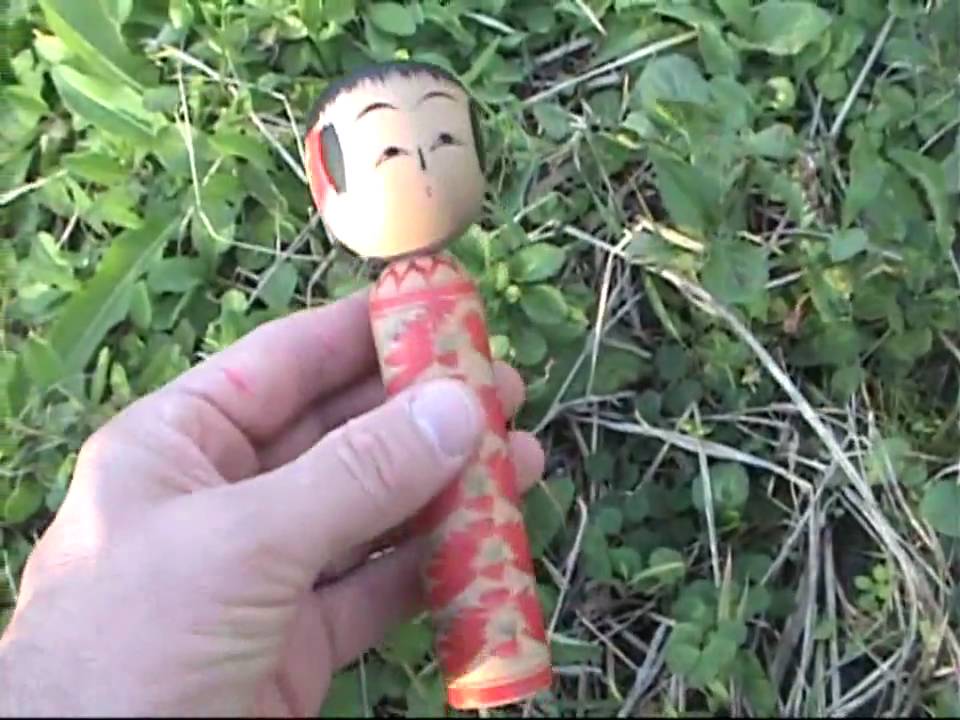🎎 Lovely Japanese wooden kokeshi doll. This pretty doll is less than 40 years old and is in fair condition with marks and scratches from handling and slight discoloration and stains from age and display. Please read below to learn about the history of kokeshi dolls, one of Japan’s most unique and distinctive folk crafts.
Size:
Height: 5.9 inches (15.0 centimeters)
Weight: 2.8 ounces (79 grams)
More about Kokeshi
Kokeshi wooden dolls are one of the most unique and interesting of Japan’s many traditional folk crafts. Originating in the early 19th century in the northern spa towns of Miyagi prefecture, kokeshi are thought to have first been produced as toys for children from leftover bits of scrap wood. These early dolls were made by craftsmen who earned their living producing other types of woodcraft, but who eventually began to create kokeshi to be sold as souvenirs in the area’s many local hot spring resorts. Over time the craft was refined, with many regional varieties appearing reflecting a wide range of technical and artistic variation. Today there are several schools of kokeshi design led by master craftsmen who often pass their trade to succeeding generations within their own family.
When collecting kokeshi it is important to note that you will likely encounter two main types; dolls which are made by artists and those which are mass-produced to be sold as souvenirs. The former are usually one-of-a-kind originals created by dedicated artisans who take their work very seriously and place great emphasis on traditional design and appearance. The other type of kokeshi are those which are manufactured specifically to be sold as souvenirs of famous or interesting places such as resorts or hot springs. These are produced en-mass, and while often attractive and interesting memorabilia they are not as frequently sought after by collectors and usually command a lower selling price. How can you determine if a kokeshi is an ‘artist’ or ‘craftsman’ style doll? This is actually quite easy as artist dolls are normally signed (on the bottom) by the maker, and may have no other writing on the body of the doll besides decorative calligraphy. Souvenir types on the other hand are normally unsigned and may have the name of the place which sold them conspicuously visible on the body of the doll. Collectors of Kokeshi typically place special emphasis on the facial quality of the dolls, desiring certain types – gentle or mischievous for example – over others. One interesting Japanese Kokeshi collector we previously met expressed a preference for newer dolls over older ones, fearing the older dolls may be haunted. (KB)
item code: R1S4-0006000
ship code: L1650 http://directorzone.cyberlink.com/video/5762
Sourced with care by Kurt Bell in Shizuoka City, this Kokeshi doll invites one into a world of traditional craftsmanship, tales of bygone eras, and the beauty that arises from simplicity. Its gentle curves, painted motifs, and serene expression capture the essence of Japanese aesthetics and the joys of handmade treasures.
Journey alongside Kurt, an American sojourner born in 1964, as he showcases pieces steeped in sentiment, history, and art. Navigating life with Stoic wisdom and insights from “Going Alone”, he curates artifacts that resonate with cultural tales, emotions, and timeless charm. 🌄📚🎎
➡️ Get your copy of Going Alone at this link (the hardcover edition is recommended) 🤠🏜️☀️: https://a.co/d/6SORY8N
Website: https://goingalone.org
Email: dinnerbytheriver@gmail.com
Support my endeavors on Patreon: https://www.patreon.com/softypapa
Be safe… But not too safe.
#KurtBell #ForSale #KokeshiFigurine #TheGoodLife #StoicExplorer 🍚🏞️🎎
CREDITS:
“Japanese Falls” image: Lane Brown | View More: http://lanebrownart.blogspot.com/p/po…
“Song For Kurt” theme: Nowherians | Listen Here: http://nowherians.bandcamp.com/


2 Comments
kore wa kokeshi wa suteki da 🙂
So cute